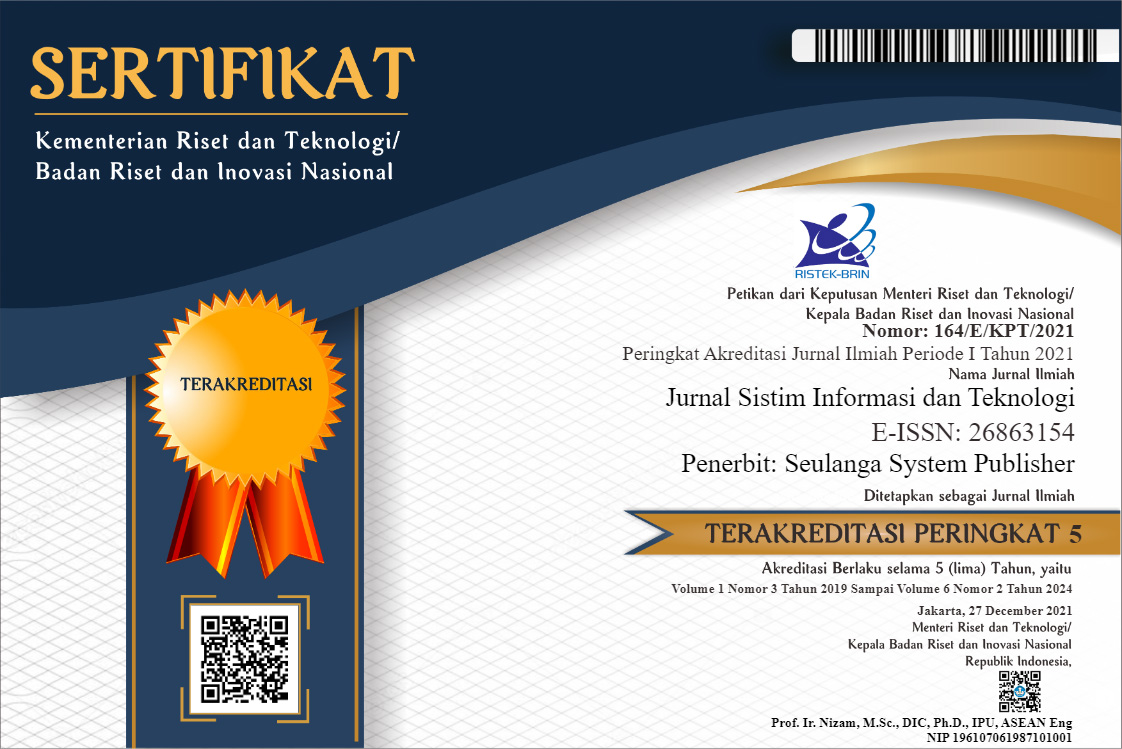Measurement Analysis of the Level of E-Commerce Adoption Readiness in SMEs Using Technology Readiness Index Method
DOI:
https://doi.org/10.60083/jsisfotek.v5i2.263Keywords:
Adoption, Readiness, IT Adoption, SMEsAbstract
The purpose of this study is to determine the extent of readiness for adoption and what factors influence readiness for e-commerce adoption. This study uses the Technology Readiness Index (TRI) model and the Information Technology Adoption Model by adding the variables of customer readiness, competitive pressure, and IT adoption. The population in this study is SMEs. The sample used from this population is 150 respondents with the purposive sampling technique. This study used quantitative methods with analysis techniques using PLS-SEM and data analysis using SmartPLS version 3.0. The results of this study indicate that six out of ten hypotheses are accepted. So that the factors that influence the readiness of e-commerce adoption are the optimism variable for the customer readiness variable, the optimism variable for the competitive pressure variable, innovativeness for the customer readiness variable, innovativeness for competitive pressure, discomfort for customer readiness, and competitive pressure for IT adoption.
References
Arfani, J. W., & Sugiyono, S. (2014). Effective Classroom Management: Research in Three High Schools. Jurnal Akuntabilitas Manajemen Pendidikan, 2(1), 44–57.
Firdaus, D. R., Harto, B., & Ferdiansyah, H. (2023). The Effectiveness Analysis of Distance Learning by Optimizing the Use of Information Technology. JISTE (Journal of Information System, Technology and Engineering), 1(1), 1–5.
Astuti, N. C., & Nasution, R. A. (2014). Technology readiness and E-commerce adoption among entrepreneurs of SMEs in Bandung city, Indonesia. Gadjah Mada International Journal of Business, 16(1), 69–88. https://doi.org/10.22146/gamaijb.5468
Ferdiansyah, H., Komaria, N., & Arief, I. (2023). The Application of Support Vector Machine Method to Analyze the Sentiments of Netizens on Social Media Regarding the Accessibility of Disabilities in Public Spaces. JISTE (Journal of Information System, Technology and Engineering), 1(1), 6–10.
Maditinos, D., Chatzoudes, D., & Sarigiannidis, L. (2014). Factors affecting e- business adoption in SMEs: an empirical research. International Journal of Commerce and Management, 24(4), 327. https://www.emeraldinsight.com/doi/pdfplus/10.1108/IJCoMA-07-2012- 0043
Sarumaha, Y. A., Firdaus, D. R., & Moridu, I. (2023). The Application of Artificial Bee Colony Algorithm to Optimizing Vehicle Routes Problem. JISTE (Journal of Information System, Technology and Engineering), 1(1), 11–15.
Parasuraman, A., & Colby, C. L. (2015a). An Updated and Streamlined Technology Readiness Index: TRI 2.0. Journal of Service Research, 18(1). https://doi.org/10.1177/1094670514539730
Saufi, M., Rofi’i, A., & Firdaus, D. R. (2023). The Analysis of User Intention to Subscribe Netflix Using UTAUT Framework. JISTE (Journal of Information System, Technology and Engineering), 1(1), 16–20.
Mahendra, A., Shalini, W., Parulian, T., Sari, G., & Octavia, C. S. (2023). PELATIHAN PENGGUNAAN APLIKASI MENDELEY BAGI MUDA MUDI DI PERHIMPUNAN MAHASISWA SAMOSIR (PERMASI). Community Development Journal: Jurnal Pengabdian Masyarakat, 4(2), 3302-3306.
Parasuraman, A., & Colby, C. L. (2015b). An Updated and Streamlined Technology Readiness Index: TRI 2.0. Journal of Service Research, 18(1), 59–74. https://doi.org/10.1177/1094670514539730
Meisarah, F., Octiva, C. S. ., Sucipto, P. A. ., Satyaninrum, I. R. ., & Bakri, A. A. (2023). Improving Student Text Writing Ability by Utilizing the Use of Augmented Reality Feature. Jurnal Sistim Informasi Dan Teknologi, 5(1), 129–134.
Parasuraman, Ananthanarayanan. (2000). Technology Readiness Index (TRI) a multiple-item scale to measure readiness to embrace new technologies. Journal of Service Research, 2(4), 307–320.
Agus Rofi’i, Firdaus, D. R., & Moridu, I. (2023). The Analysis of User Acceptance Using UTAUT and Delone & McLean Model: Study Case of Banking Mobile Application. JISTE (Journal of Information System, Technology and Engineering), 1(1), 21–25.
Sani, A., & Wiliani, N. (2019). Factors of Readiness and Adoption of Information Technology in the Context of Technology and Environment in MSMEs in Jakarta. JITK (Jurnal Ilmu Pengetahuan Dan Teknologi Komputer), 5(1), 49–56. https://doi.org/10.33480/jitk.v5i1.616
Subiyakto, A., Ahlan, A. R., Kartiwi, M., & Putra, S. J. (2016). Measurement of the information system project success of the higher education institutions in Indonesia: a pilot study. International Journal of Business Information Systems, 23(2), 229–247.
Downloads
Published
How to Cite
Issue
Section
License
Copyright (c) 2023 Jurnal Sistim Informasi dan Teknologi

This work is licensed under a Creative Commons Attribution 4.0 International License.









